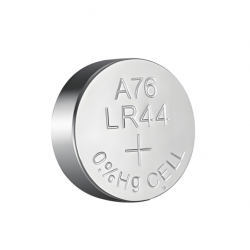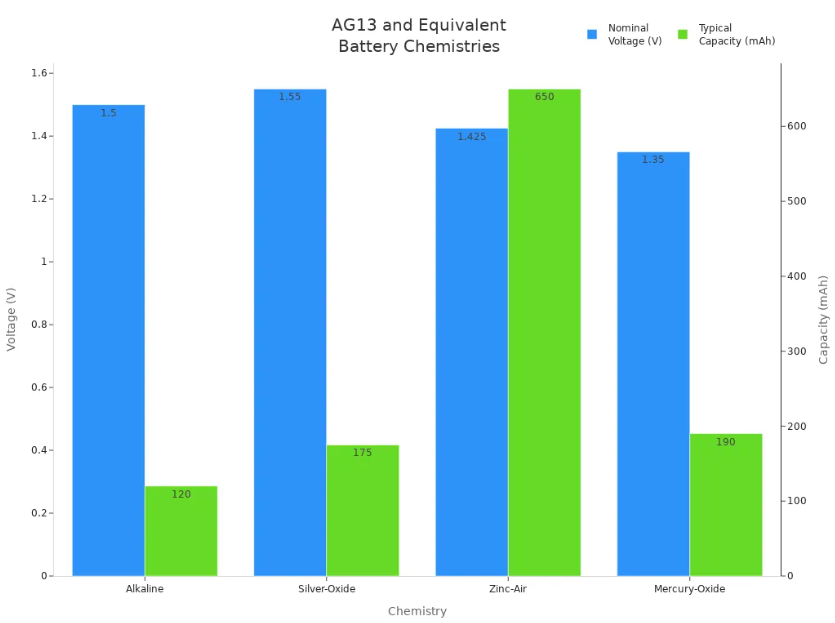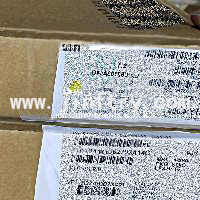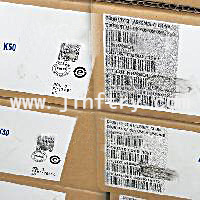A76 battery equivalent advantage comparison

A76 battery equivalent advantage comparison
A76 battery replacement options include the AG13,LR44, SR44 , and 357. Each type is suitable for many small devices, such as watches, remote controls, calculators, and small toys. You may notice that the LR44 and AG13 use alkaline batteries, while the 357 and SR44 use silver oxide batteries.
LR44 batteries are easy to find and meet most needs, but some devices require a more stable voltage, which can be provided by 357 or SR44 batteries. Before selecting a button battery, be sure to check the specifications of your device, as the right A76 battery will ensure the safe and smooth operation of your device.
|
Equivalent Battery Name |
Chemistry |
Voltage |
Typical Capacity (mAh) |
Common Applications |
|
AG13 |
Alkaline |
1.5V |
110–150 |
General button-cell applications |
|
LR44 |
Alkaline |
1.5V |
110–150 |
Toys, calculators, watches |
|
SR44 |
Silver Oxide |
1.55V |
150–200 |
High-drain devices |
|
357 |
Silver Oxide |
1.55V |
150–200 |
Medical devices, watches |
Common Uses for A76 Batteries
A76 batteries are commonly found in many everyday items. They power watches, remote controls, calculators, and small toys. Many medical devices, such as digital thermometers, blood glucose meters, and blood pressure monitors, also use A76 batteries. Some laser pointers and small flashlights also rely on A76 batteries due to their compact size and reliable power delivery.If you use a TV remote, car remote, or small video game remote, you may have noticed an A76 battery inside. A76 batteries are ideal for devices that require long-lasting, stable power. You can trust A76 batteries to keep your device running smoothly.
A76 Battery Overview
What are A76 batteries?
You often use A76 batteries in small electronic devices (such as electronic watches, calculators, and remote controls). These batteries are button cells. They are round and flat, fitting into the tight spaces inside devices. There are two main types of A76 batteries: alkaline and silver oxide. Silver oxide batteries are called SR44, while alkaline batteries are also called LR44. Both batteries have similar dimensions, approximately 11.6 mm in diameter and 5.4 mm in height. They are also lightweight, typically weighing between 1.8 and 2.28 grams.
Below is a brief introduction to the technical details of the SR44 and LR44 batteries:
|
Specification |
Details |
|
Battery Type |
Alkaline (LR44) or Silver Oxide (SR44) |
|
Nominal Voltage |
1.5 V (Alkaline), 1.55 V (Silver Oxide) |
|
Capacity |
150-200 mAh (Alkaline), 150-170 mAh (Silver Oxide) |
|
Size (Diameter x Height) |
11.6 mm x 5.4 mm |
|
Weight |
1.8 to 2.28 grams |
|
Chemistry |
Alkaline manganese dioxide, Silver Oxide |
|
Temperature Range |
-10°C to 60°C (14°F to 140°F) |
|
Shelf Life |
3-5 years (Alkaline), 5-10 years (Silver Oxide) |
|
Equivalent Models |
LR154, SR1154,AG13, 357, SR44 |
From the above data, we can see that the a76 battery has a stable voltage and a long service life. The chemical characteristics inside the a76 battery enable it to continue to provide power for months or even years.
LR44
The LR44 battery is a more common A76 equivalent. It uses alkaline button cell chemistry, meaning its core is zinc and manganese dioxide. The nominal voltage of an LR44 battery is 1.5 volts. This voltage slowly decreases with use. LR44 batteries are commonly found in electronic remote controls, calculators, and watches. They are less expensive than silver oxide batteries.LR44 batteries are suitable for devices that don't require a stable voltage. If your device requires long-term power or requires a stable voltage, you may want to use a silver oxide battery. LR44 batteries typically last from several months to over a year, depending on how often you use the device. For low-power devices where cost is a priority, LR44 batteries should be used.
Provides stable voltage and longer lifespan;
better for devices needing consistent power
Suitable for low to moderate power, cost-effective;
performance declines faster under continuous use
Feature
SR44 Battery (Silver Oxide)
LR44 Battery (Alkaline)
Chemistry
Silver Oxide and Zinc
Zinc and Manganese Dioxide (Alkaline)
Nominal Voltage
Approximately 1.55 volts
1.5 volts
Voltage Behavior
Voltage remains stable throughout discharge
Voltage drops significantly during discharge
Capacity
Typically 150-200 mAh
Typically 110-130 mAh
Shelf Life
5-10 years; less risk of leakage
3-5 years; moderate risk of leakage over time
Performance
NOTE: LR44 batteries are physically interchangeable with 357, AG13, and SR44, but the chemistry will affect their performance.
357
357 batteries stand out from A76 batteries because they typically use a silver oxide chemistry. This results in a higher and more stable voltage of 1.55 volts. 357 batteries maintain this voltage until they are depleted. This makes them ideal for devices that require a reliable power source, such as watches, calculators, and small medical devices.
357 batteries last longer than LR44 or AG13 batteries, especially in high-powered devices. You can often use 357 batteries instead of LR44 or AG13 batteries. However, 357 batteries are more expensive. If your device requires a stable voltage and a longer battery life, 357 batteries are a better choice.
|
Characteristic |
LR44 / AG13 Battery (Alkaline) |
357 Battery (Silver Oxide) |
|
Chemistry |
Alkaline |
Silver oxide |
|
Capacity |
Generally lower capacity |
Higher capacity (~150-190 mAh) |
|
Voltage Stability |
Voltage drops steadily during use |
Relatively constant voltage (~1.55V) |
|
Lifespan |
Shorter lifespan, especially in high-drain devices |
30% to 100% longer lifespan |
|
Suitability |
Less suitable for high-drain devices due to voltage drop and lower capacity |
Ideal for high-drain and precision devices |
SR44
The SR44 battery is another silver oxide battery equivalent to the A76 battery. It has a nominal voltage of 1.55 volts and uses a silver oxide chemistry. The SR44 battery offers stable voltage, which is crucial for precision equipment such as watches and medical instruments.
SR44 batteries last longer than LR44 and AG13 batteries and have a lower risk of leakage. SR44 batteries are more expensive, but they offer better performance in devices that require a stable power supply. They should be used in devices that require the highest accuracy and reliability.
| Feature | SR44 (Silver Oxide) | LR44 (Alkaline) |
|---|---|---|
| Voltage | 1.55 V | 1.5 V |
| Chemistry | Silver oxide | Alkaline Zinc Manganese |
| Voltage Stability | Stable, flat discharge profile | Voltage drops over time |
| Energy Density | Higher energy density | Lower energy density |
| Typical Use | Watches, calculators, precision devices | General electronics, toys, thermometers |
| Impact on Precision Use | Consistent voltage ensures accuracy | Voltage fluctuations can affect device performance |
The AG13 battery is another commonly used equivalent to the A76 battery. It is nearly identical to the LR44 battery. Both utilize an alkaline button cell chemistry and have a nominal voltage of 1.5 volts. AG13 batteries also use zinc and manganese dioxide. You'll see AG13 batteries in watches, calculators, and other applications.
The capacity of an AG13 battery is approximately 110-130 mAh.
The voltage decreases over time, just like an LR44 battery.
Most AG13 batteries are alkaline, but some silver oxide versions also exist.
AG13, LR44, and A76 batteries are often labeled as equivalent.
AG13 batteries can replace LR44 or A76 batteries. The main difference is the labeling. Performance and lifespan are nearly identical. If you need a longer-lasting battery, you should opt for a silver oxide battery like the 357 or SR44.

A76 Interchangeability and Key Differences
LR44, AG13, 357, and SR44 batteries are all the same size and generally interchangeable. However, it's important to consider that different chemistries and voltages may affect how your device operates.
LR44 and AG13 are 1.5V alkaline button batteries, and their voltage drops with use.
357 and SR44 are 1.55V silver oxide batteries, which offer a stable voltage and a longer lifespan.
Devices requiring stable power, such as watches or medical tools, perform better with silver oxide batteries.
Toys and calculators can use LR44 or AG13 batteries, as they are more affordable.
Tip: The appropriate A76 battery for your electronic device depends on the environment it's used in. Silver oxide batteries are more expensive, but offer a longer lifespan and better performance.
Battery Comparison Chart
Voltage and Chemistry
When comparing equivalent A76 batteries, you'll notice that voltage and chemistry play a significant role in quality and performance. LR44 and AG13 batteries use alkaline chemistry. These batteries have a nominal voltage of 1.5 volts. 357 and SR44 batteries use silver oxide chemistry, resulting in a slightly higher voltage of approximately 1.55 volts. This subtle difference can have a significant impact on device performance, especially in devices that require a stable power supply.
As you can see from the table below, LR44 and AG13 batteries are well-suited for high-drain or pulse applications. However, their voltage decreases with use, which may affect the quality of some devices. 357 and SR44 batteries have a more stable voltage, making them better suited for devices that require a steady supply. Choosing the right chemistry will help you get the best performance from your A76 battery.
| Battery Model | Chemistry | Nominal Voltage | Voltage Stability | Typical Use Cases |
|---|---|---|---|---|
| LR44 | Alkaline | 1.5 V | Drops over time | Toys, calculators, watches |
| AG13 | Alkaline | 1.5 V | Drops over time | General electronics, games |
| 357 | Silver Oxide | 1.55 V | Stays steady | Medical devices, watches |
| SR44 | Silver Oxide | 1.55 V | Stays steady | Precision devices, instruments |
AG13 Advantages
There are many reasons to choose AG13 batteries for your small electronic devices. These batteries provide reliable power and excellent everyday use. Here are some key advantages:
AG13 batteries have a high capacity, so your devices can run longer without frequent replacements.
They're reliable in outdoor conditions, from freezing cold to scorching hot. They operate in temperatures ranging from -4°F (-20°C) to 140°F (approximately 72°C).
AG13 batteries have a low self-discharge rate, maintaining their charge even during storage. You can store them for up to three years and they'll retain their quality.
AG13 batteries are mercury-free and leak-proof, making them safer and more environmentally friendly.
You can use AG13 batteries in many devices, such as watches, calculators, toys, medical tools, and remote controls.
Their compact size is ideal for small devices, helping you maintain their performance quality.
AG13 batteries are compatible with many other brands and types of batteries. This versatility enhances their overall quality.
You'll find AG13 batteries are priced lower than some name-brand batteries, making them a smart choice for quality batteries on a budget.
AG13 Disadvantages
Before choosing one, you should also be aware of the drawbacks of AG13 batteries. Some issues may affect your device experience.
AG13 batteries have a shelf life of 3 to 7 years, but storing them in an unused device can cause leakage. Leakage can damage your device and degrade its quality.
The metal casing may corrode over time, especially if the battery is stored in a device that's not actively used.
The chemical composition of AG13 batteries makes them more susceptible to leakage if stored improperly. This can affect the quality of your electronics.
Actual battery life depends on how often you use your device, temperature fluctuations, and how long the battery was stored before use. These factors can affect the battery's performance.
You must handle AG13 batteries with care. Even though they don't contain mercury, improper handling can harm the environment and reduce recycling quality.
| Benefit / Feature | Description |
|---|---|
| Compact Size | Fits many small devices like watches and toys. |
| Reliable Voltage Output | Provides a steady 1.5V, supporting consistent quality in device operation. |
| Long-lasting Energy Delivery | Capacity supports long-term use, helping you get more quality time from your devices. |
| Economical Cost | Offers good quality at a lower price. |
| Mercury-free and Anti-leak Design | Ensures safety and maintains the quality of your electronics. |
LR44 Advantages and Disadvantages
LR44 Advantages
There are many reasons to choose LR44 batteries as an A76 replacement. LR44 batteries are suitable for low-power devices and offer the following advantages:
LR44 batteries are ideal for many small electronic devices, such as watches, calculators, and medical equipment. Their compact size makes them easy to use in tight spaces.
You'll get a nominal voltage of 1.5V, which meets the needs of most A76 devices.
LR44 batteries provide reliable and stable power for everyday use. You can trust them to keep your devices running smoothly.
Many users prefer LR44 batteries because they offer a good value. Using LR44 batteries is more cost-effective than using more expensive alternatives.
LR44 batteries are readily available. They're available in most stores, making replacing A76 batteries a simple task.
This battery has a high energy density relative to its size, meaning it can store a large amount of power in a small package.
LR44 batteries operate over a wide temperature range. Your device will maintain good performance in both hot and cold environments.
Compared to other alkaline batteries, LR44 batteries have a longer lifespan. Even after years of inactivity, LR44 batteries will continue to function when needed.
LR44 batteries are safe for most everyday use. They rarely leak and rarely cause malfunctions in low-power devices.
You can use LR44 batteries in many different devices, demonstrating their versatility and quality.
LR44 Disadvantages
While LR44 batteries offer many advantages, there are also disadvantages you should consider before using them as an A76 replacement:
LR44 batteries have a sloping discharge curve. Their voltage continuously drops during use, which may affect device performance.
Devices that require a stable voltage may not be compatible with LR44 batteries. Voltage drops can cause sensitive electronic devices to malfunction or stop working.
LR44 batteries have a moderate capacity, typically between 110 and 130 mAh. Devices with higher power requirements may need to have their batteries replaced more frequently.
LR44 batteries don't offer the extended lifespan and more stable voltage of SR44 batteries. This can affect the quality of precision equipment.
You may notice that the voltage of LR44 batteries quickly drops below 1.4 volts and drops to 1.0 volt near the end of their lifespan. This can cause reliability issues with some A76 devices.
Frequent battery replacement can be annoying and may reduce the overall quality of your device experience.
LR44 batteries are not well suited for high-power or precision applications. Devices requiring a stable power supply may be better suited for silver oxide batteries.
Some users report that LR44 batteries don't last as long as they expected, especially in demanding devices.
LR44 batteries may not meet the quality standards required for medical or scientific instruments.
Before choosing an LR44 battery as an A76 equivalent, you should always check whether your device requires a more stable power source.
Tip: For the best quality and longest lifespan, choose LR44 batteries from a trusted brand. A good brand reputation generally means better performance.
If your device requires stable voltage or longer shelf life, consider using silver oxide batteries for better quality and performance.
SR44 Advantages and Disadvantages
SR44 Advantages
Choosing SR44 batteries for your devices offers numerous advantages. SR44 batteries utilize silver oxide chemistry and provide a stable voltage of 1.55 volts. They are ideal for devices requiring a stable power supply, such as small medical devices, electronic watches, and precision instruments.
SR44 batteries provide stable and reliable power. Your blood glucose meter or digital thermometer will always display accurate results.
This battery offers high energy density, a compact size, and a high power output, making it ideal for compact devices.
SR44 batteries last longer than most alkaline batteries. You don't need to replace them as frequently.
The low self-discharge rate means the batteries retain their charge during storage. Your spare batteries are always ready for use.
SR44 batteries are leak-proof. This protects your sensitive electronic devices from damage.
The compact size makes them suitable for small portable devices. You can use SR44 batteries in watches, medical monitors, and other miniature devices.
SR44 batteries do not contain mercury. This makes them safer for the environment. Stable voltage output supports the accuracy and reliability of medical and precision equipment.
SR44 Disadvantages
Before choosing an SR44 battery, you should also understand its disadvantages. This type of battery is more expensive than alkaline batteries. The silver oxide inside is expensive, and the manufacturing process is more complex.
SR44 batteries are more expensive than LR44 or AG13 batteries. You pay extra for better performance and longer life.
The voltage difference between the SR44 (1.55V) and LR44 (1.5V) can cause problems. Some devices may not work properly if the wrong type is used.
The slight size difference between the SR44 and LR44 may cause discomfort. Your device may lose connection or stop working.
Not all devices require the stable voltage of the SR44. For simple toys or calculators, a cheaper battery may be sufficient.
Tip: Choose an SR44 battery for devices that require stable, long-lasting power and high precision. Always check the manual for your device and purchase SR44 batteries from a trusted brand.
This helps avoid compatibility issues and ensures proper functioning of your device.
A76 FAQ
Are A76 and LR44 the same?
LR44 and A76 are the same type of button cell battery, designated by different naming systems. They are identical in specifications, dimensions, and intended use and can be used interchangeably.
Specifications and Compatibility Analysis
LR44 and A76 are essentially the same type of alkaline button cell battery; the main differences stem from manufacturer or regional naming conventions.
What devices use A76 equivalents?
You can often find A76 equivalents in watches, calculators, electronic remote controls, toys, medical devices, and small flashlights. Many remote controls and digital thermometers also use these batteries. Always check your device's manual to confirm the correct battery type.
How to safely store A76 batteries?
A76 batteries should be stored in a cool, dry place. Keep away from metal objects, direct sunlight, and fire. Use the original packaging or battery case to prevent short circuits. Check the battery expiration date before use.
Are A76 batteries rechargeable?
No, A76 batteries are not rechargeable. A76 batteries must be replaced when depleted. Never recharge them, as this may cause leakage or damage.
Can I use an SR44 battery instead of an LR44?
In most cases, they can be used interchangeably, but be aware of your device's voltage sensitivity. The SR44 and LR44 batteries have a slight voltage difference (SR44 is 1.55V, LR44 is 1.5V), but they have the same dimensions (11.6mm diameter x 5.4mm thickness), making them interchangeable in most cases.
How do I dispose of used A76 batteries?
Used A76 batteries should be taken to a local battery recycling center. Do not discard them in the trash. Proper recycling helps protect the environment and keeps hazardous materials out of landfills.







